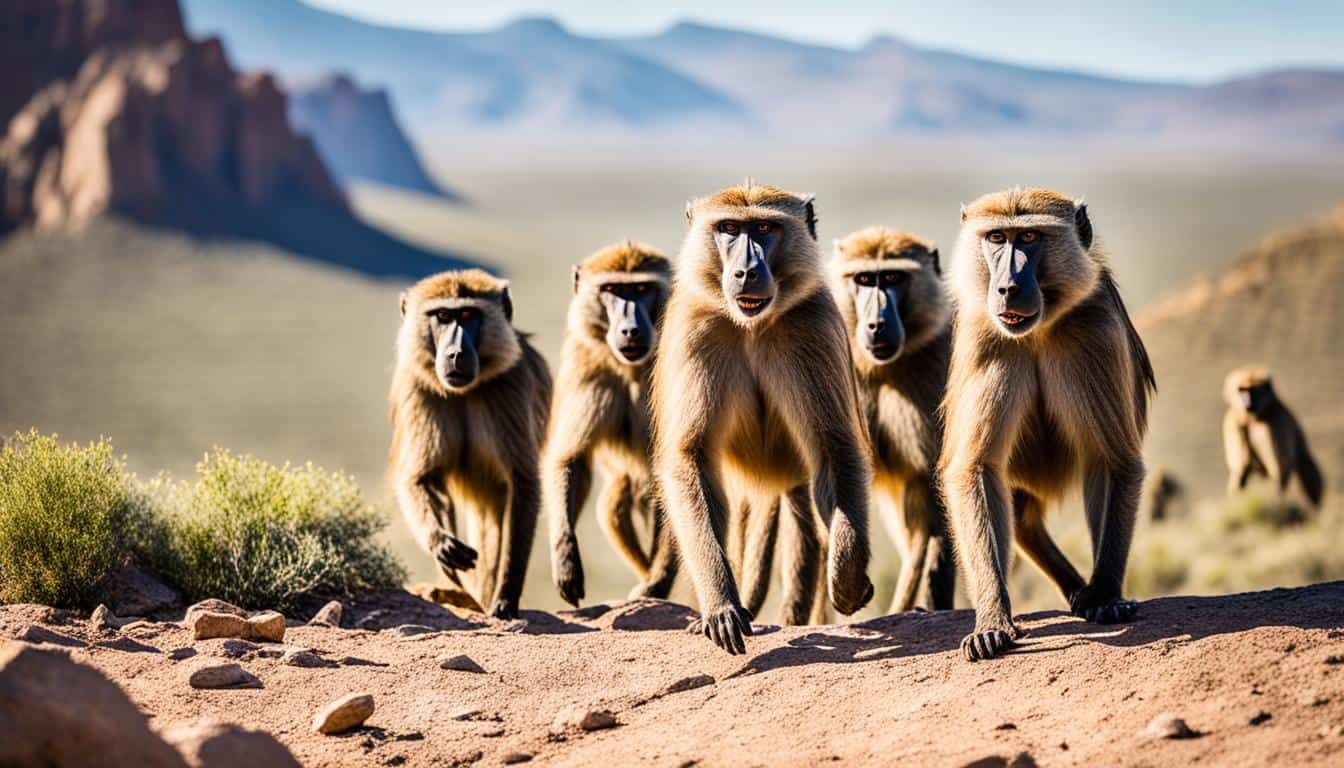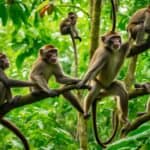Many think baboons only live in Africa, mainly in sub-Saharan areas. So, it seems unlikely to find wild baboons in the USA. Yet, baboons are known for being able to live in various places, raising doubt about this idea. In the USA, primates are usually kept in facilities, like zoos or as exotic pets. Therefore, wild baboons are not found naturally in the USA.
However, a few baboons have escaped captivity over the years. This led to some rare sightings in the US. Although these events are uncommon, they get a lot of public interest. So, while it’s not likely to see baboons in the USA, their ability to adapt keeps the topic interesting.
Introduction to Baboons
Baboons are exceptional Old World monkeys. They are well-known for their complex societies and unique behaviors. While these amazing animals don’t live in the Americas, understanding their traits is key to admiring them.
Baboons’ Characteristics and Behavior
Known for their strong bodies and expressive faces, baboons are mainly earth-bound. They have long faces and sharp teeth. Their social life is highly organized in groups that can be very large. In these groups, they have clear rankings and communicate in many ways.
Diet and Social Structure
Baboons eat a variety of foods, from fruits to small animals. They often look for food together, strengthening their group bonds. The groups are centered around females and their young, while males come and go. This helps keep their gene pool diverse.
Females work together to raise the young ones. They keep them safe and teach them survival skills. This shows how important their social connections are. It also gives us a peek into their well-organized societies.
Habitat of Baboons
Baboons are originally from Africa. They live in many places, from dry North to green South Africa. This makes them very adaptable to different environments.
Native Regions of Baboons
In sub-Saharan Africa, baboons can be found. For instance, olive baboons live from Sudan’s semi-deserts to Kenya’s grasslands. They show great resilience and ability to adjust to various settings within this region.
Adaptability to Different Environments
Baboons’ adaptability is quite remarkable. They can live in different kinds of places like forests, deserts, and even mountains. This flexibility shows that, in theory, they could live in America. But, there are no wild baboons there.
Baboons are adaptable primate species, showing incredible ability to change their diet, behavior, and where they live. This adaptability helps them a lot in the wild, making them very interesting for researchers.
Baboons in Captivity in the United States
In the United States, baboons are often kept in sanctuaries and facilities. The Born Free USA Primate Sanctuary near San Antonio, Texas, is a key place. It offers a safe and stimulating space for rescued baboons and primates.
Born Free USA Primate Sanctuary
At the Born Free USA Primate Sanctuary, different species like olive, hamadryas, and hybrid baboons live. These primates may have come from labs or private homes. Here, they have freedom and can act like they would in the wild.
Research Facilities and Exotic Pets
Baboons also live in U.S. research facilities, where they take part in studies. This work is important but raises ethical concerns about using smart animals. Some baboons are even kept as pets. Yet, because of their complex nature, they often end up in places like Born Free USA.
| Location | Type | Primate Species |
|---|---|---|
| Born Free USA Primate Sanctuary, TX | Sanctuary | Olive Baboons, Hamadryas Baboons, Hybrid Baboons |
| Various Research Facilities | Research | Multiple Baboon Species |
Are there wild baboons in the USA?
The question about North American baboon population interest many. Currently, the USA does not have wild baboons living freely. Baboons seen outdoors in the country usually escaped from places like zoos, labs, or homes.
Rare incidents draw our notice when it happens. Conservationists and pet lovers often find the idea fascinating. It’s clear that these baboons are not native but brought there by people.
Wild Primate Species Found in the United States
North America has a variety of native wildlife. But it’s interesting to note it also has some primate species. The sightings of wild apes in the United States spark the interest of many.
Native Primates of North America
Squirrel monkeys and capuchins are native to certain regions of North America. They live in places like tropical forests and sub-tropical areas. These monkeys have adapted well to their surroundings, showing how versatile they are.
Introduction of Foreign Species
In some cases, foreign species like baboons found their way into the U.S. from the exotic pet trade or by escaping captivity. This issue was generally caused by human actions. However, these baboons couldn’t make a permanent home in the U.S.
No foreign primate, including baboons, has managed to live and reproduce in the wild of the U.S. Some reports suggest sightings, but these are mostly from animals that got free from private collections.
Wildlife Sanctuaries in the USA
Wildlife sanctuaries in the United States give a home to baboons and other primates in need. They make sure these animals can act just as they would in the wild. These places are key for helping our ecosystems stay healthy, something we all benefit from.
Role of Wildlife Sanctuaries
In the USA, wildlife sanctuaries are a safe place for animals that have suffered. They work hard to heal animals, both physically and mentally. The goal is to give them a life that feels as close to their natural home as possible.
Examples of Primate Sanctuaries
Some American sanctuaries do amazing work with baboons and other primates. For example, the Born Free USA Primate Sanctuary in Texas cares for over 600 primates. They let these animals enjoy a more natural life, away from the stress of being in captivity.
Other key sanctuaries are the Primate Rescue Center in Kentucky and the Center for Great Apes in Florida. They are fully committed to helping these smart animals. They focus on providing them with better lives, full of care and respect.
Baboons’ Natural Habitat and Range
Baboons are mainly found in Africa. They live in many different places, from the highlands of Ethiopia to the grasslands of southern Africa. The baboon natural range shows how well they can adapt to different places. They live in savannahs, woodlands, and even rocky areas.
Their natural range is wide and covers a lot of ecosystems. But, it doesn’t include the United States. This shows how good they are at living in dry and wet regions.
Baboons can be found in countries like Ethiopia, Kenya, Tanzania, Botswana, and South Africa. These places have different climates and landscapes. This proves how strong and adaptable they are in their natural homes. Their behaviors and bodies help them live in many places.
| Region | Climate | Habitat Type |
|---|---|---|
| Ethiopian Highlands | Temperate | Mountainous |
| Kenyan Savannah | Tropical | Grasslands |
| Tanzanian Woodlands | Subtropical | Woodlands |
| Botswana | Arid | Deserts |
| South African Grasslands | Temperate | Grasslands |
Knowing about the baboon natural range helps us see how they can live in so many places. This knowledge is important for studying and protecting them. Even though they don’t live in the United States, their adaptability gives us clues about how they survive and why they are important for nature.
Challenges Facing Baboons in the Wild
Baboons are tough monkeys. They fight against big problems in their homes. These problems can hurt their chances of survival and their numbers.
Habitat Loss
The biggest issue for baboons is losing where they live, like when farms grow or cities expand. This makes their living areas smaller. It’s harder for them to get food and find safe places to sleep. Some types of baboons, like guinea and hamadryas, are at higher risk. They need certain kinds of space to live that are quickly disappearing.
Hunting and Human Conflict
Baboons also face big problems with hunting and fights with people. In some places, they’re killed for being pests or for food. This makes their groups smaller. When baboons go looking for food in farms or cities, conflicts happen. Sometimes, people hurt them because of this. It’s a big issue for protecting baboons. It not only affects their numbers but also their family lives and how they grow their groups.
| Challenges | Impact on Baboons |
|---|---|
| Habitat Loss | Fragmented habitats, reduced food sources, threat to survival |
| Hunting | Population decline, disrupted social structures |
| Human Conflict | Retaliatory killings, stress on baboon troops |
Conservation Efforts for Baboons
Baboons are threatened, so saving them is crucial. Efforts include making laws to protect them. Plus, groups like the Born Free USA help look out for them.

Legislative Protection
Rules are in place to keep baboons safe from harm. For instance, the Captive Primate Safety Act looks after them. It controls who can own and sell baboons.
Having laws that protect baboons is very important. It helps ensure their safety and rights. These measures are a big part of keeping baboons safe.
Animal Welfare Organizations
Organizations worldwide help protect baboons. Places like the African Wildlife Foundation do a lot. They keep baboons safe and fight against illegal activities that harm them.
These groups work on many things. They keep the baboons’ homes safe, teach people about why baboons matter, and help stop illegal hunting.
They also make laws stronger around the world. Plus, they look after baboons that have suffered. Their work is crucial for baboon survival. It combines on-the-ground efforts with policy change.
Exotic Pets and the Law
Exotic pets, like baboons, have specific laws in the U.S. These laws aim to keep animals and people safe. But, different states have different rules, making things complex. If you want an exotic pet, it’s key to know your state’s laws.
Laws Regulating Exotic Pet Ownership
Exotic pet laws come from federal, state, and local levels. A law called the Captive Wildlife Safety Act bans big cats’ selling, but baboons follow other rules. States like California and New York forbid owning many exotics. Yet, places like Nevada are more relaxed. Be sure to check your state’s rules before getting an exotic.
Challenges with Enforcement
Enforcing exotic pet laws is tough. Illegal sales of these animals are hard to stop, bypassing checks. Also, there aren’t enough resources for groups that protect wildlife, making it harder to enforce laws. This situation can lead to dangers for both the animals and people.
Exotic pet laws are a big and tricky issue. They have to protect animals and the public. But, work is always needed to make these laws better and enforcement smoother.
FAQ
Are there wild baboons in the USA?
No, the USA doesn’t have baboons except in captivity. If you see one, it probably escaped from a zoo or a personal collection.
What are the characteristics and behavior of baboons?
Baboons are known for their strong social groups. Living in troops, they have complex hierarchies. They communicate using both sounds and body language.
Males often show they’re in charge by barking and screaming. Meanwhile, females are busy taking care of the young.
What is the diet and social structure of baboons?
These animals eat almost anything, from fruits to small creatures. They form big groups with several male leaders.
These males lead with a community of females and their young. It shows how they work together to survive.
Where are baboons native to?
Baboons call Africa home, mainly living in the sub-Saharan area. You can find them in a variety of places, from semi-deserts to wooded areas.
Olive baboons are among the most common types across this region.
Are baboons adaptable to different environments?
Yes, baboons are quite adaptable. They can be found in forests, deserts, and even mountains. This skill helps them live in various places.
Where can I find baboons in captivity in the United States?
You can find baboons at places like the Born Free USA Primate Sanctuary in Texas. It offers them a safe place after being rescued from various backgrounds.
Are there any North American baboon populations?
No, there aren’t any established baboon populations in North America. If you see one, it’s likely from a human-made event, like escapees.
What native primates exist in North America?
North America has some native primates like squirrel monkeys and capuchins in certain areas. But it doesn’t have wild baboons or other African primates outside of captivity.
Have foreign primate species been introduced to the USA?
Some foreign primates have entered the U.S. through trade or captivity. Despite this, they have not managed to form lasting wild populations. This includes baboons.
What role do wildlife sanctuaries play in the USA?
Sanctuaries in the USA offer a safe haven for primates, including baboons. They are key in both conservation and animal welfare areas.
Can you name some primate sanctuaries in the USA?
Places like the Born Free USA Primate Sanctuary in Texas provide care for primates. They often take in animals that were involved in research or were former exotic pets.
What is the natural habitat and range of baboons?
Baboons live in different parts of Africa, from highlands to grasslands. They are found in places like savannahs, woodlands, and rocky terrains.
What challenges do baboons face in the wild?
These primates are under threat from losing their homes to farming and development. They also face danger from humans, leading to hunting and being pushed out.
What conservation efforts are in place for baboons?
Many groups fight for the safety and conservation of baboons. They work on laws to protect them and on-the-ground projects to save their habitats.
What laws regulate exotic pet ownership in the USA?
In the U.S., each state has its own rules about owning exotic pets, including baboons. The laws aim to keep both the animals and the public safe and well.
What challenges exist in enforcing exotic pet laws?
It’s hard to enforce these laws due to secret sales and not enough resources. With different rules in each state, keeping control is a big challenge.







